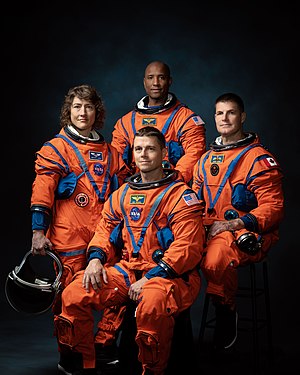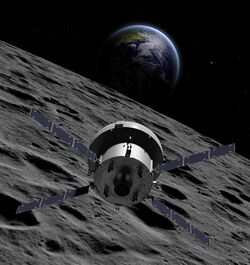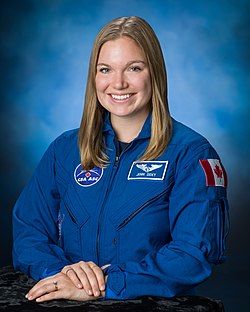Astronomy:Artemis 2
 Summary of the Artemis 2 mission plan | |
| Names | Artemis 2 Exploration Mission-2 (EM-2) |
|---|---|
| Mission type | Crewed lunar flyby |
| Operator | NASA |
| Mission duration | 10 days (planned) |
| Spacecraft properties | |
| Spacecraft | Orion CM-003 |
| Crew | |
| Crew size | 4 |
| Members | Reid Wiseman Victor Glover Christina Koch Jeremy Hansen |
| Start of mission | |
| Launch date | September 2025 (planned)[1] |
| Rocket | SLS Block 1 |
| Launch site | Kennedy Space Center, LC-39B[2] |
| Contractor | NASA |
| End of mission | |
| Recovered by | U.S. Navy (San Antonio-class amphibious transport dock) |
| Landing site | Pacific Ocean (planned) |
| Flyby of Moon | |
| Distance | 6,400 mi (10,300 km) (planned)[3] |
 Official Crew Portrait (Clockwise from left) Koch, Glover, Hansen, Wiseman | |
Artemis 2 (officially Artemis II)[4] is the second scheduled mission of NASA's Artemis program and the first scheduled crewed mission of NASA's Orion spacecraft, currently planned to be launched by the Space Launch System (SLS) no earlier than September 2025.[1] Four astronauts are to perform a flyby of the Moon and return to Earth, being the first crewed mission beyond low Earth orbit since Apollo 17 in 1972. The mission is also planned to be the first crewed launch from Launch Complex 39B of the Kennedy Space Center since STS-116 in 2006.
Originally designated Exploration Mission-2 (EM-2), the mission was intended to collect samples from a captured asteroid in lunar orbit by the now-canceled robotic Asteroid Redirect Mission;[5] it was renamed after the introduction of the Artemis program.
History
In 2017, Exploration Mission-2 was a projected single-launch mission of a Space Launch System (SLS) Block 1B with an Exploration Upper Stage, lunar Block 1 Orion spacecraft, and a payload insertion of 50.7 t (55.9 short tons; 112,000 lb). The plan was to rendezvous with an asteroid previously placed in lunar orbit by the robotic Asteroid Redirect Mission and have astronauts perform space-walks and gather samples.[6] After the cancellation in April 2017[7] of the Asteroid Redirect Mission, an 8-day mission was proposed with a crew of four astronauts, sent on a free-return trajectory around the Moon.[8] Another proposal suggested in 2017 was to take four astronauts aboard Orion on an 8-to-21–day trip around the Moon to deliver the first element of the Deep Space Gateway.[9] In March 2018, it was decided to launch the first Gateway module on a commercial launch vehicle[10] because of delays in building the Mobile Launcher needed to hold the more powerful Exploration Upper Stage.[11] The launcher was selected to be the Falcon Heavy.[12]
On 11 February 2023, NASA flipped the engine section for the Artemis 2 core to horizontal, the final major milestone before mating the section to the rest of the vehicle. On March 20, the engine section was mated with the Artemis 2 core stage in Building 103 at the Michoud Assembly Facility. NASA expected the core stage, complete with engines, to be delivered to the Kennedy Space Center in summer 2023.[13] In May, they pushed the delivery date five months back to late fall 2023.[14][15] The RS-25 engines now installed on the core stage in New Orleans (As of September 2023) have serial numbers E2047, E2059, E2062, and E2063.[16][17]
The crew was announced on April 3, 2023, as stated by NASA Administrator Bill Nelson, in his "State of NASA" speech reacting to President Joe Biden's FY2024 budget proposal.[18] The announcement occurred at a special event at a NASA facility at Ellington Field outside Houston.[19] They appeared later that day at nearby NRG Stadium for the 2023 March Madness championship game.[20]
Proposed secondary payloads
NASA's CubeSat Launch Initiative (CSLI) sought proposals in 2019 from U.S. institutions and U.S. companies to fly their CubeSat missions as secondary payloads aboard the SLS on the Artemis 2 mission.[21][22] NASA would accept proposals for both 6-unit (12 kg, 26 lb) and 12-unit (20 kg, 44 lb) CubeSats.[23] As with the Artemis 1 mission, the CubeSats flying on Artemis 2 were to be mounted on the inside of the stage adapter ring between the SLS upper stage and the Orion spacecraft, and will be deployed after Orion separates.[23] Selections were initially planned to be made by February 2020,[21] but in October 2021, NASA dropped all secondary payloads from the mission.[24]
Launch date
During preliminary reviews in 2011, the launch date was placed somewhere between 2019 and 2021, but afterwards the launch date was delayed to 2023.[25][26] As of January 2024, the mission is expected to launch no earlier than September 2025.[1]
| Date | Estimated launch date |
|---|---|
| 2011 | Between 2019 and 2021 |
| 2018 | September 2022 |
| 2019 | 2023 |
| January 2024 | No earlier than September 2025 |
Crew
| Position | Astronaut | |
|---|---|---|
| Commander | Second spaceflight | |
| Pilot | Second spaceflight | |
| Mission Specialist | Second spaceflight | |
| Mission Specialist | First spaceflight | |
Artemis 2 is to be crewed by four astronauts: Commander Reid Wiseman, Pilot Victor J. Glover, Mission Specialist Christina Koch, and Mission Specialist Jeremy Hansen.[27] Jenni Sidey-Gibbons is Hansen's backup; she will join the mission if Hansen is unable to.[28][29]
Glover, Koch, and Hansen are to be the first person of color, woman, and non-American to go beyond low Earth orbit respectively.[27] Hansen and Sidey-Gibbons are Canadian and have been assigned by the Canadian Space Agency;[27] a 2020 treaty between the United States and Canada led to their involvement.[30]
Mission
The Artemis 2 mission plan is to send four astronauts in the first crewed Orion MPCV spacecraft into a lunar flyby for a maximum of 21 days using the Block 1 variant of the Space Launch System. The mission profile is a multi-trans-lunar injection (MTLI), or multiple departure burns, and includes a free-return trajectory from the Moon. The Orion spacecraft will be sent to a high Earth orbit with a period of roughly 24 hours. During this time the crew will perform various checkouts of the spacecraft's life support systems as well as an in-space rendezvous and proximity operations demonstration using the spent Interim Cryogenic Propulsion Stage (ICPS) as a target. When Orion reaches perigee once again, it will fire its main engine to complete the TLI maneuver, which will send it to a lunar free-return trajectory, before returning to Earth.[3][31]
Optical communications
Artemis 2 will test and demonstrate optical communications to and from Earth using the Orion Artemis II Optical Communications System (O2O).[32] The O2O hardware will be integrated into the Orion spacecraft and includes an optical module (a 4 in [100 mm] telescope and two gimbals), modem and control electronics.[32] O2O will communicate with ground stations in California and New Mexico.[32] The test device will send data to Earth with a downlink rate of up to 260 megabits per second.[33]
Similar missions
Flown
In December 1968, the Apollo 8 mission, crewed by astronauts Frank Borman, Jim Lovell, and William Anders, flew their command and service module beyond low Earth orbit and completed ten orbits of the Moon. Similar to the planned Artemis 2 mission in that it was crewed and did not land, it differed by being placed into orbit.[34] Apollo 13 (1970) was the only Apollo mission that flew past the Moon by a free-return trajectory.
Proposed
In 2005, the company Space Adventures announced plans for a lunar tourism mission to take two tourists within 100 km (62 mi) of the lunar surface using a Soyuz spacecraft piloted by a professional cosmonaut. The mission, named DSE-Alpha, has been priced at US$150 million per seat and was expected to last 8–9 days when scheduled. Company CEO Eric Anderson stated in 2011 that one seat had been sold, but the launch date has continually slipped as the second seat remained unsold (As of 2017).[35]
A SpaceX lunar tourism mission was initially proposed for late 2018 and would have been similar to Artemis 2 in crew size, with two space tourists paying for a free-return loop around the Moon and back to Earth, using the Crew Dragon capsule and launched on the Falcon Heavy.[36][37] After the first flight of Falcon Heavy in 2018, SpaceX announced that Falcon Heavy would not be used for crewed flights to focus their future development on Starship and indicated that the lunar mission would more likely be carried out with the Starship.[38][39] On 14 September 2018, SpaceX officially announced that it had signed one of the paying passengers, Yusaku Maezawa, for the dearMoon project mission using Starship and that he would invite six to eight artists to join him.[40][41]
References
- ↑ 1.0 1.1 1.2 Foust, Jeff (9 January 2024). "NASA delays Artemis 2 and 3 missions". SpaceNews. https://spacenews.com/nasa-delays-artemis-2-and-3-missions/.
- ↑ Hill, Bill (March 2012). "Exploration Systems Development Status". NASA Advisory Council. http://www.nasa.gov/pdf/630149main_5-Hill_SLS%20MPCV%20GSDO_508.pdf.
 This article incorporates text from this source, which is in the public domain.
This article incorporates text from this source, which is in the public domain.
- ↑ 3.0 3.1 Hambleton, Kathryn (2018-08-27). "First Flight With Crew Important Step on Long-Term Return to Moon". http://www.nasa.gov/feature/nasa-s-first-flight-with-crew-important-step-on-long-term-return-to-the-moon-missions-to.
- ↑ Artemis: brand book (Report). Washington, D.C.: National Aeronautics and Space Administration. 2019. NP-2019-07-2735-HQ. "MISSION NAMING CONVENTION. While Apollo mission patches used numbers and Roman numerals throughout the program, Artemis mission names will use a Roman numeral convention."
 This article incorporates text from this source, which is in the public domain.
This article incorporates text from this source, which is in the public domain.
- ↑ Foust, Jeff (March 25, 2015). "NASA Selects Boulder Option for Asteroid Redirect Mission". SpaceNews. http://spacenews.com/nasa-selects-boulder-option-for-asteroid-redirect-mission/.
- ↑ Wall, Mike (April 10, 2013). "Inside NASA's Plan to Catch an Asteroid (Bruce Willis Not Required)". Space.com. http://www.space.com/20612-nasa-asteroid-capture-mission-explained.html.
- ↑ Foust, Jeff (June 14, 2017). "NASA closing out Asteroid Redirect Mission". SpaceNews. http://spacenews.com/nasa-closing-out-asteroid-redirect-mission/.
- ↑ Hambleton, Kathryn (August 4, 2017). "NASA's First Flight With Crew Will Mark Important Step on Journey to Mars". https://www.nasa.gov/feature/nasa-s-first-flight-with-crew-will-mark-important-step-on-journey-to-mars.
 This article incorporates text from this source, which is in the public domain.
This article incorporates text from this source, which is in the public domain.
- ↑ Gebhardt, Chris (April 6, 2017). "NASA finally sets goals, missions for SLS – eyes multi-step plan to Mars". https://www.nasaspaceflight.com/2017/04/nasa-goals-missions-sls-eyes-multi-step-mars/.
- ↑ "NASA FY 2019 Budget Overview". p. 14. https://www.nasa.gov/sites/default/files/atoms/files/nasa_fy_2019_budget_overview.pdf. "Supports launch of the Power and Propulsion Element on a commercial launch vehicle as the first component of the LOP - Gateway"
 This article incorporates text from this source, which is in the public domain.
This article incorporates text from this source, which is in the public domain.
- ↑ Berger, Eric (2018-04-13). "NASA may fly crew into deep space sooner, but there's a price" (in en-us). https://arstechnica.com/science/2018/04/nasa-likely-to-fly-first-deep-space-mission-on-less-powerful-rocket/. "Without the Exploration Upper Stage, NASA will not be able to fly, in a single flight, crew members and pieces of a deep space gateway it hopes to build near the Moon in the 2020s"
- ↑ Foust, Jeff (2021-02-10). "NASA selects Falcon Heavy to launch first Gateway elements" (in en-US). https://spacenews.com/nasa-selects-falcon-heavy-to-launch-first-gateway-elements/.
- ↑ Richardson, Derek (23 March 2023). "Artemis 2 Space Launch System core stage nearly complete". https://www.spaceflightinsider.com/missions/artemis-program/artemis-2-space-launch-system-core-stage-nearly-complete/.
- ↑ Clark, Stephen (September 29, 2023). "Rocket Report: Iran launches satellite; Artemis II boosters get train ride". https://arstechnica.com/space/2023/09/rocket-report-iran-launches-satellite-artemis-ii-boosters-get-train-ride/.
- ↑ Sloss, Philip (May 2, 2023). "Artemis II Moon mission transitioning from planning to preparation". https://www.nasaspaceflight.com/2023/05/artemis-ii-update/.
- ↑ Mohon, Lee; O'Brien, Kevin (October 27, 2022). "Space Launch System Engines: Launching Artemis Astronauts to the Moon". http://www.nasa.gov/exploration/systems/sls/space-launch-system-engines-launching-artemis-astronauts-to-the-moon.html.
- ↑ Mohon, Lee (September 25, 2023). "All Engines Added to NASA's Artemis II Moon Rocket Core Stage – Artemis". https://blogs.nasa.gov/artemis/2023/09/25/all-engines-added-to-nasas-artemis-ii-moon-rocket-core-stage/.
- ↑ Foust, Jeff (March 9, 2023). "White House proposes $27.2 billion for NASA in 2024". https://spacenews.com/white-house-proposes-27-2-billion-for-nasa-in-2024/.
- ↑ Pearlman, Robert Z. (2023-04-03). "NASA Announces the Astronaut Crew for Artemis II Lunar Flyby" (in en). https://www.scientificamerican.com/article/nasa-announces-the-astronaut-crew-for-artemis-ii-lunar-flyby/.
- ↑ Koch, Christina (11 April 2023). "You stood. All of you. You stood for taking on the challenge. For doing things that are hard. For exploring together. Of all the things we did last week to introduce Artemis II, this unexpected standing ovation was the moment I realized—You're all behind this. We are going." (in en). https://twitter.com/Astro_Christina/status/1645612953259974657?cxt=HHwWgoC9zeOQstYtAAAA.
- ↑ 21.0 21.1 Hill, Denise (6 August 2019). "NASA's CubeSat Launch Initiative Opens Call for Payloads on Artemis 2 Mission". https://www.nasa.gov/feature/nasa-s-cubesat-launch-initiative-opens-call-for-payloads-on-artemis-2-mission. "NASA is seeking proposals from U.S. small satellite developers to fly their CubeSat missions as secondary payloads aboard the SLS on the Artemis 2 mission under the agency's CubeSat Launch Initiative (CSLI)"
 This article incorporates text from this source, which is in the public domain.
This article incorporates text from this source, which is in the public domain.
- ↑ Klotz, Irene (5 August 2019). "NASA Scouting Cubesats For Artemis-2 Mission". https://aviationweek.com/awinspace/nasa-scouting-cubesats-artemis-2-mission. "NASA on August 5 released a solicitation for cubesats to ride along with the first crewed flight of the Space Launch System rocket and Orion capsule, with the caveat that selected projects fill strategic knowledge gaps for future lunar and Mars exploration"
- ↑ 23.0 23.1 Foust, Jeff (2019-08-08). "NASA seeking proposals for cubesats on second SLS launch" (in en-US). https://spacenews.com/nasa-seeking-proposals-for-cubesats-on-second-sls-launch/.
- ↑ Kurkowski, Seth (2021-10-21). "Alabama students forced to pivot satellite design after being dropped from Artemis II" (in en-US). https://spaceexplored.com/2021/10/21/alabama-students-forced-to-pivot-satellite-design-after-being-dropped-from-artemis-ii/.
- ↑ Hambleton, Kathryn (March 8, 2019). "NASA's Deep Space Exploration System is Coming Together". https://www.nasa.gov/feature/nasa-s-deep-space-exploration-system-is-coming-together.
 This article incorporates text from this source, which is in the public domain.
This article incorporates text from this source, which is in the public domain.
- ↑ Sloss, Philip (December 28, 2018). "Crewed Orion spacecraft passes critical design review". https://www.nasaspaceflight.com/2018/12/crewed-orion-passes-critical-design-review/.
- ↑ 27.0 27.1 27.2
- O'Shea, Claire (2023-04-03). "NASA Names Astronauts to Next Moon Mission, First Crew Under Artemis". http://www.nasa.gov/press-release/nasa-names-astronauts-to-next-moon-mission-first-crew-under-artemis.
- Wall, Mike (2023-04-03). "Meet the 4 astronauts flying on NASA's Artemis 2 moon mission" (in en). https://www.space.com/artemis-2-moon-mission-astronauts-meet-the-crew.
- Wattles, Jackie; Strickland, Ashley (2023-04-03). "The four astronauts NASA picked for the first crewed moon mission in 50 years" (in en). https://www.cnn.com/2023/04/03/world/artemis-2-astronaut-crew-scn/index.html.
- Stamm, Amy. "Meet the Crew of Artemis II" (in en). https://airandspace.si.edu/stories/editorial/meet-crew-artemis-ii.
- ↑ "Canadian Space Agency astronauts Jenni Gibbons and Joshua Kutryk to contribute to future missions, from the International Space Station to the Moon". Cision. CNW Group (Longueuil, Quebec). 22 November 2023. https://www.newswire.ca/news-releases/canadian-space-agency-astronauts-jenni-gibbons-and-joshua-kutryk-to-contribute-to-future-missions-from-the-international-space-station-to-the-moon-898470181.html.
- ↑ Nassar, Hana Mae (22 November 2023). "Canadian astronauts receive new assignments". CityNews (Vancouver). https://vancouver.citynews.ca/2023/11/22/canadian-astronauts-gibbons-kutryk/.
- ↑ Connolly, Amanda (December 16, 2020). "A Canadian astronaut will be on NASA's Artemis deep space lunar orbit as well the first non American to leave earth orbit". Global News. https://globalnews.ca/news/7525408/nasa-artemis-program-canadian-astronaut-moon/.
- ↑ Sloss, Philip (25 June 2020). "NASA studying practice rendezvous options for Artemis 2 Orion". https://www.nasaspaceflight.com/2020/06/nasa-rendezvous-options-artemis-2-orion/.
- ↑ 32.0 32.1 32.2 Murphy, Kendall (June 3, 2021). "Lasers Light the Way for Artemis II Moon Mission". NASA. https://esc.gsfc.nasa.gov/news/Lasers_Light_the_Way_for_Artemis_II_Moon_Mission/.
- ↑ Schauer, Katherine (August 11, 2022). "What's Next: The Future of NASA's Laser Communications". http://www.nasa.gov/feature/goddard/2022/the-future-of-laser-communications.
- ↑ Wood, Charlie (25 February 2017). "Apollo 8 redux: Why NASA may send humans around the Moon, again". The Christian Science Monitor. http://www.csmonitor.com/Science/Spacebound/2017/0225/Apollo-8-redux-Why-NASA-may-send-humans-around-the-moon-again.
- ↑ Moseman, Andrew (April 26, 2011). "Just One US$150 Million Seat Remains on Space Adventures' Lunar Flyby". Popular Mechanics. http://www.popularmechanics.com/space/rockets/a13025/just-one-150-million-seat-remains-on-space-adventures-lunar-flyby/.
- ↑ Grush, Loren (3 March 2017). "SpaceX promises a Moon vacation in 2018". The Verge. https://www.youtube.com/watch?v=A9R3Ndv7958.
- ↑ Trumbore, Dave (27 February 2017). "SpaceX Will Attempt to Send Humans Around the Moon Next Year". http://nerdist.com/spacex-will-attempt-to-send-humans-around-the-moon-next-year/.
- ↑ Foust, Jeff (2018-02-06). "SpaceX no longer planning crewed missions on Falcon Heavy" (in en-US). https://spacenews.com/spacex-no-longer-planning-crewed-missions-on-falcon-heavy/.
- ↑ Pasztor, Andy (6 February 2018). "Elon Musk Says SpaceX's New Falcon Heavy Rocket Unlikely to Carry Astronauts". The Wall Street Journal. https://www.wsj.com/articles/elon-musk-says-spacexs-new-falcon-heavy-rocket-unlikely-to-carry-astronauts-1517876582?mod=rss_Technology.
- ↑ Ralph, Eric (14 September 2018). "SpaceX has signed a private passenger for the first BFR launch around the Moon". Teslarati. https://www.teslarati.com/spacex-private-passenger-bfr-moon-mission/.
- ↑ Grush, Loren (14 September 2018). "SpaceX says it will send someone around the Moon on its future monster rocket". https://www.theverge.com/2018/9/13/17857872/spacex-moon-trip-passenger-announcement-bfr.
External links
- Artemis II, at NASA
- Mission Overview, at NASA
 |






